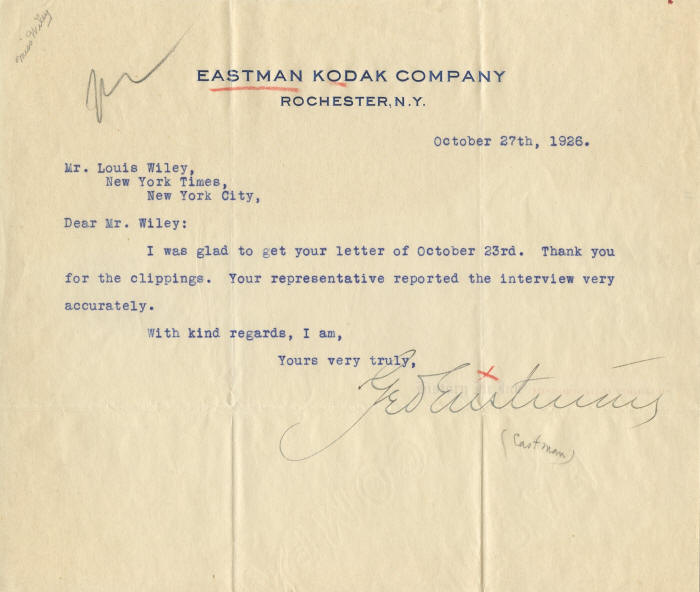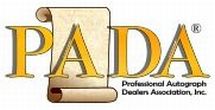1431444
George Eastman
Scroll down to see images of the item below the description
Eastman thanks The New York Times for clippings, likely of stories about his first African safari
George Eastman, 1854–1932. American entrepreneur, businessman, and philanthropist. Rare Typed Letter Signed, Geo Eastman, one page, 8½" x 7¼", on engraved stationery of the Eastman Kodak Company, Rochester, New York, October 27, 1926.
Eastman, a reticent man who never married, wrote comparatively few letters. In History Comes to Life, Kenneth Rendell notes that his letters are “very rare." Our search of auction records found only 22 Eastman letters offered at auction over the last 40 years.
This letter comes from a private collection that was assembled in the 1940s and has not been on the market since then. In it, Eastman writes to Louis Wiley of The New York Times to thank him for newspaper clippings, likely stories of Eastmanʼs hunting expedition to Africa earlier that month. He writes, in full: "I was glad to get your letter of October 23rd. Thank you for the clippings. Your representative reported the interviews very accurately."
In October 1926, at age 72, Eastman returned from his first safari in East Africa. It was no small affair. He had planned an extended safari and was joined from New York by his personal physician, Dr. Audley D. Stewart, and banker and sportsman Daniel E. Pomeroy. The three sailed from New York to Southampton, England, on board the Majestic in March. En route to Africa, Eastman stopped in London to test British-made elephant guns and stopped for business in Paris. Eastman and his companions then motored to Genoa, Italy, from which they sailed aboard the Llanstephan to the Kenyan port city of Mombassa. There they met famous wildlife researchers and photographers Martin and Osa Johnson; taxidermist Carl Akeley and his wife, who set up the safari headquarters in Nairobi, Kenya; and Phil Percival, who would be Eastmanʼs guide, and his wife. The enlarged group took a private train, consisting of a passenger car, dining car, and baggage car, to Nairobi. There Eastman employed a Boer chauffer and 30 African valets, cooks, porters, gun bearers, skinners, and mule handlers. At its height, the Eastman party included 13 cars, 80 African natives, 28 camels, and five mules. The hunters killed more than 100 animals, including gazelles, cheetahs, lions, rhinoceroses, and impalas. Eastman bagged his limit of five lions, including one that stood its ground to protect a lioness and two cubs. By August, the group decided that it had taken enough trophies, and it spent the remaining time filming in the wild, including a native lion hunt with spears. The next year, Eastman privately published an account of the safari in Chronicles of An African Trip (1927).
Eastman revolutionized photography with his invention of roll film and an inexpensive, popular camera. In 1883, he announced the production of film in rolls—far from the hard, dry plates then in use—and a roll holder that would adapt to nearly every plate camera on the market. In 1885, Eastman introduced the first transparent photographic film as we know it today. The following year, he hired a full-time research chemist to work on commercializing a flexible, transparent film base. He coined the word “Kodak,” which he devised from his favorite letter, “K,” and the Kodak camera appeared in 1888. The simple, handheld camera was preloaded with 100 exposures, and people could take pictures with the touch of a button. The first commercial transparent roll film appeared in 1889—making possible Thomas Edisonʼs 1891 invention of the Kinetograph, an innovative motion picture camera with rapid intermittent film movement.
Eastman formed the Eastman Dry Plate Company in 1881. It became the Eastman Dry Plate and Film Company in 1884, the Eastman Company in 1889, and finally the Eastman Kodak Company of New York in 1892.
This letter is in fine condition. There are pencil notations in blank areas at the upper left and a note identifying Eastman beneath his signature. There are also red pencil underlines beneath "eastman kodak" in the letterhead and a red pencil “x" above Eastman's signature. One horizontal fold affects the signature, which Eastman has signed with a large gray-black fountain pen.
Unframed. Click here for information on custom framing this piece.
Please click here to contact us regarding the availability of this item.





